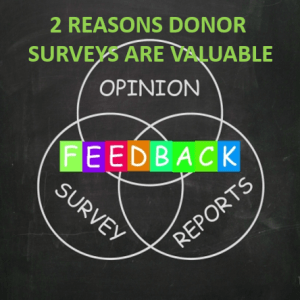There are two reasons you should do a donor survey.
Donor surveys offer you a “twofer.” One is for you (useful information); the other is for your donor (a way to usefully participate other than giving money).
Let’s begin with the latter reason.
1. Do it for your donors. Create community so they feel loved.
I begin here because often nonprofits censor themselves before they’ve even thought through the potential benefits. They worry more about what they might lose than what they might gain. They tell me they don’t want to “bother” their donors. They think people won’t respond, at best, or will be ticked off, at worse.
Au contraire – if you do it well.
A good survey says you care about what your donors think and feel.
And donors really do want you to care about them for more than their money. They don’t want to be simply wallets to you. Or just anonymous people stored in your database.
Donors join your cause, usually, because they want to feel part of a community of like-minded people.
They want to express their values… do something meaningful… and be loved.
It may not be the first thing they’ll tell you if you ask them why they made a gift. But if you dig a little – ask a few questions – you’ll get to it.
Fostering community is a very important part of retaining supporters.
Without community, you’ve got a bunch of folks just smushed together — but they derive no meaning from each other. This doesn’t feel that great, so these folks move on to another place that might be more embracing.
Embrace your donors if you’ll have them embrace you.
A “community” is a group that cares for its members.
What fosters this embracing, caring emotion?
- Understanding.
- Empathy.
- Walking in your donors’ shoes.
This is why we talk so much about “donor centered” fundraising.
But how can you be truly donor-centered if you have no clarity on what interests, attitudes and goals your supporters share? Finding out requires a bit of research.
Sure, it’s easier to make assumptions. To guess. Sometimes you’ll come close but that’s pretty indirect, and it’s certainly no way to build a community around shared values. It just creates a ‘hypothetical group persona’ with whom you’re corresponding.
A survey is a way to get direct, first-hand feedback from your supporters and learn what they honestly care about.
When you ask supporters direct questions, they stop being just a spectator and become a participant. They feel good about you and your cause, because you’ve asked them to help pitch in. You’ve shown them that they matter.
Surveys get people involved.
And when you get folks involved in actions other than giving money, it increases their propensity to give again.
2. Do it for you. Learn how to satisfy donors so you’ll get and keep more of them.
I recently read a dynamite article, Why Did You Buy? A Deceivingly Important Question To Ask Clients, by Sean D’Souza on the Psychotactics Blog. Substitute “give” for “buy” and “donors” for “clients” and you’ve got your marching orders!
Ask supporters why they support you!
This question is important for three reasons:
- It validates the purchase (aka donation) decision
- It gives you an understanding into the trigger (the gift motivator)
- You can better manage expectations (what benefit the donor wants as a result)
Surveys Validate the Donation Decision
The decision to donate is emotional.
Emotions can be tricky. When people give, they’re often faced with a bit of “buyer’s remorse.”
- Will they really use my gift as I intended?
- Will they steward my gift appropriately?
- Do they really need this gift more than other organizations?
- Did I get pressured into giving too much?
- Will they think I gave too little?
- Will I ever be able to find out what outcome was created by this gift?
Donors need reassurance that their emotional decision was a good one.
When you ask your donor why they gave (or why they gave to a particular program or campaign), you’re asking them to write down their reasoning. When they do this, they confirm to themselves that they made a “good decision. ” So they feel better, and this strengthens their resolve to sustain a connection with you.
Once people have made a good decision, they’re more apt to make that same decision again.
Structure your survey so you get emotion-based responses. Logically, people will tell you they bought milk because they needed it for cereal. But if you need a carton of milk, and there are three same-priced brands among which to choose, you’ll select one based on emotion.
The same is true for nonprofits. Yours is likely not the only charity on the block that does something akin to what you do. So what is it, emotionally, that triggers your donor to give specifically to you?
Surveys Help You Understand Donor Motivation Triggers
You need to learn what triggers donor philanthropy – because you’re also looking for new donors who might give for the same reason!
- I gave because you helped me/someone I love.
- I gave because you thanked me personally.
- I gave because I trust the leadership.
- I gave because your cause tugs on my heart strings.
- I gave because belonging to this community is meaningful to me.
- I gave because the timing was urgent.
When people respond positively to your appeals, do you know why? It’s likely you’re not exactly sure which part of that copy resonated most with your donor. You might think it was the matching grant challenge. Your board president might think it was the story you told about someone you helped. Your E.D. might think it was the part about the amazing number of people you helped last year. Your marketing officer might think it was the subject line of your email appeal.
Donor feedback is invaluable to inform future content marketing and fundraising strategy. You can:
- Tweak you website home page copy
- Change the language on your donation landing page
- Review and modify annual appeal copy
- Alter e-mail subject lines
- Adjust your newsletter and annual report format
- Revise your blog content
- Modify social media content
- and much more!
Surveys Help You Manage Donor Expectations
When you actively dialogue with folks about why they gave, you find out how your donor hoped to benefit from their act of philanthropy.
The reasons may be tangible (“I got to join the ‘Inner Circle’;” “I got my photo taken with a celebrity“). If you dig a bit deeper, more often they’re intangible and emotional (“I fulfilled a moral obligation“; “I continued a tradition of giving taught to me by my parents“; “I gave back to an organization that helped me, so that others can be helped“, etc.)
If your donor doesn’t end up getting what they expected (e.g., a feeling of belonging to an elite group because they received personal attention; a sense that they made a significant difference because you reported to them on outcomes), they end up feeling short-changed.
Penelope Burk, in Donor-Centered Fundraising, wrote that what the majority of donors want from you is simply this:
“Show me that you know me.”
To be donor-centered you must ask questions.
- How can you communicate effectively with folks if you don’t know what they like about what you do? Or about what you are sending?
- How can you offer meaningful “donor experiences” if you don’t know what folks want?
- How can you help solve supporters’ problems if you don’t ask them about their challenges?
- How can you make sure donors are happy if you don’t try to have two-way conversations with them?
To get more details on survey “how to” check out:
- Jonathan Grapsas’ 3-part series on the benefits and ‘how-to’s’ of donor surveys.
- A sample donor survey from Grapsas on the SOFII blog.
- Information on questions to ask/not ask.
- Online survey tools and sample questions from Classy blog.
- How to develop a survey format using Type Form(Video) (the platform I used for my reader survey, below).
Truly donor-centered fundraisers work hard to understand and take their donors’ point of view to heart. In every single encounter and communication.










I tried to take the survey but it led me to a “page not found.” I was interested in seeing how you would create a survey and of what you were interested. Not sure what to do.
Thank you for the information in this blog post.